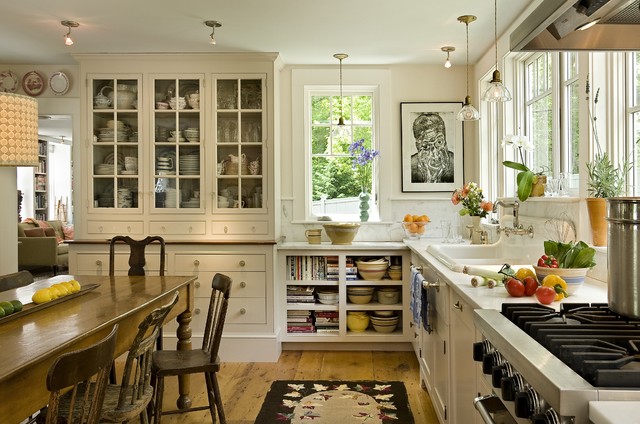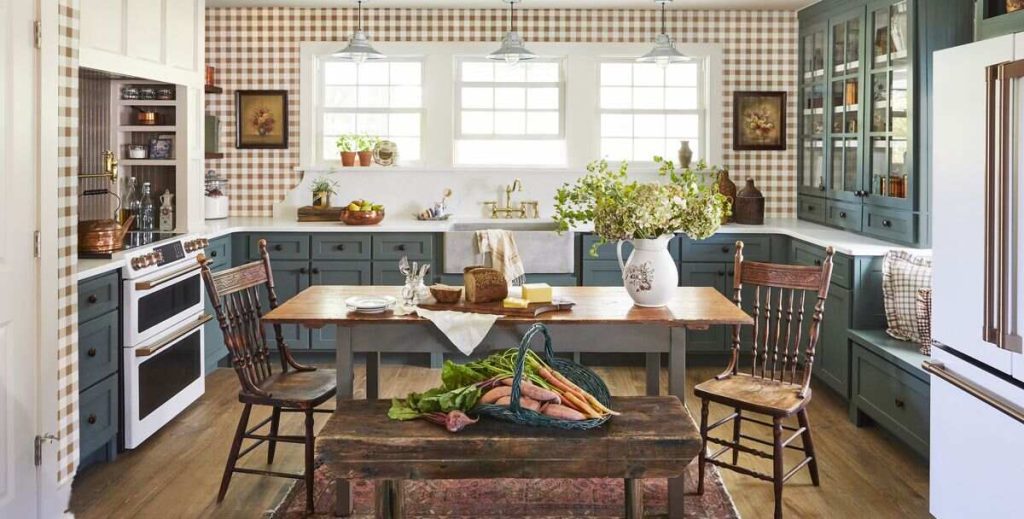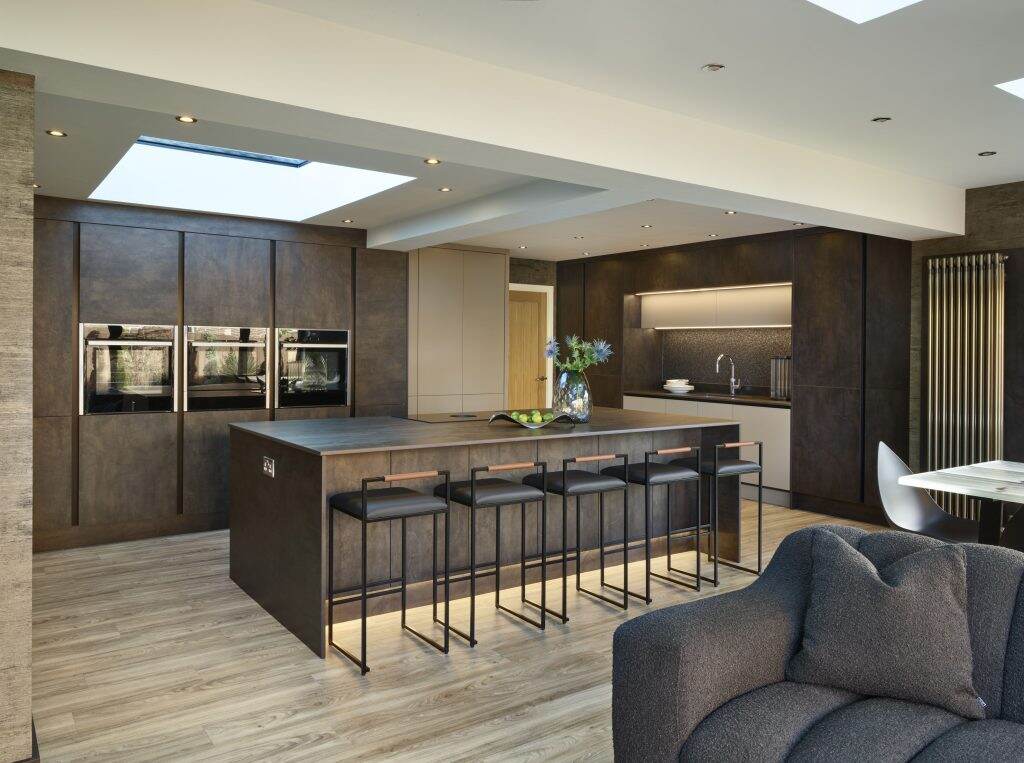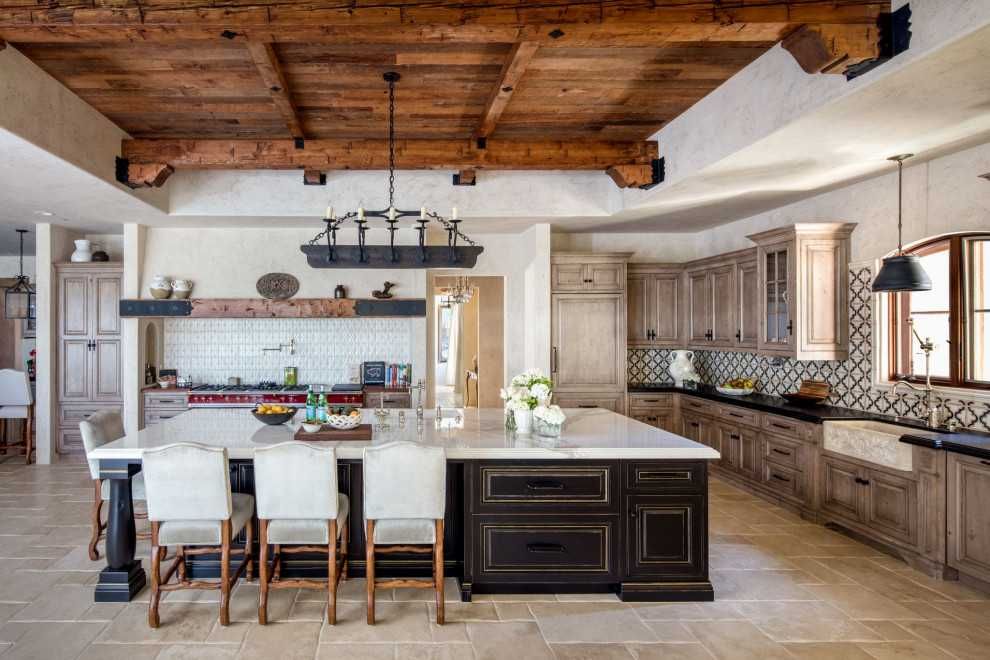Different Style Of Kitchens Over the years, kitchen designs have evolved, reflecting changes in technology, lifestyle, and aesthetics. From rustic charm to sleek modernity, let’s embark on a journey through the diverse styles of kitchens, each with its own unique appeal.

1.The Classic Kitchen
Classic kitchens are timeless, characterized by their elegant and sophisticated look. These kitchens often feature neutral color palettes, such as whites, creams, and greys, and incorporate natural materials like wood and stone. The cabinetry is typically ornate, with detailed moldings and raised panels, while fixtures and fittings might include vintage-style handles and faucets. A classic kitchen feels warm and inviting, embodying a sense of tradition and comfort.
2.The Modern Kitchen
In stark contrast to the classic style, modern kitchens emphasize minimalism and functionality. Clean lines, flat surfaces, and a monochromatic color scheme dominate this style. Cabinetry often lacks handles for a sleek look, and materials like stainless steel, glass, and concrete are prevalent. Modern kitchens also integrate cutting-edge technology, from smart appliances to advanced lighting systems. This style appeals to those who appreciate simplicity, efficiency, and a contemporary aesthetic.
3.The Rustic Kitchen
Rustic kitchens bring the charm of the countryside into the home. They are characterized by their use of natural materials such as rough-hewn wood, stone, and brick. Exposed beams, farmhouse sinks, and vintage appliances enhance the old-world feel. Colors in rustic kitchens tend to be warm and earthy, creating a cozy and inviting atmosphere. This style is perfect for those who love the idea of a homely, lived-in space with plenty of character.
4.The Industrial Kitchen
Inspired by urban lofts and factory spaces, industrial kitchens are bold and edgy. They feature raw materials like exposed brick, concrete floors, and metal surfaces. Open shelving, large kitchen islands, and commercial-grade appliances are common elements. The color palette is typically neutral, with black, grey, and metallic tones. Industrial kitchens appeal to those who appreciate a blend of ruggedness and modernity, offering a unique and functional space.
5.The Mediterranean Kitchen
Mediterranean kitchens are vibrant and full of life, drawing inspiration from the coastal regions of Spain, Italy, and Greece. These kitchens often feature warm colors like terracotta, ochre, and turquoise, along with decorative tiles and wrought iron details. Cabinets may be painted or stained in rich hues, and natural materials like stone and wood are used extensively. The overall feel is one of warmth, brightness, and a connection to nature, making it perfect for those who enjoy a lively and inviting environment.
6.The Transitional Kitchen
For those who can’t choose between traditional and contemporary, the transitional kitchen offers the best of both worlds. This style seamlessly blends classic and modern elements, creating a harmonious and balanced look. You might see sleek cabinetry paired with traditional countertops, or modern lighting fixtures combined with classic wood finishes. The color palette is usually neutral, allowing for flexibility in decor. Transitional kitchens are ideal for homeowners who want a timeless yet updated space.
7.The Scandinavian Kitchen
Scandinavian kitchens are known for their simplicity, functionality, and connection to nature. These kitchens often feature a clean, white color palette with pops of natural wood and greenery. Open shelving, minimalistic cabinetry, and functional layouts are key elements. Light is a critical component, with large windows and uncluttered spaces creating a bright and airy feel. This style is perfect for those who appreciate clean lines, practicality, and a serene atmosphere.
8.The Eclectic Kitchen
Eclectic kitchens are a playground for creativity, combining elements from various styles to create a unique and personalized space. There are no strict rules—vintage pieces can sit comfortably alongside modern fixtures, and bold colors can mix with neutral tones. Patterns, textures, and a mix of materials add to the layered look. Eclectic kitchens are ideal for those who love to experiment and express their individuality through design.
Conclusion
Different Style Of Kitchens The diversity in kitchen styles allows homeowners to tailor their spaces to reflect their personal tastes and lifestyle needs. Whether you prefer the sleek lines of a modern kitchen, the cozy charm of a rustic design, or the vibrant colors of a Mediterranean space, there’s a kitchen style to suit every preference. Ultimately, the best kitchen is one that not only meets functional requirements but also feels like the heart of the home.
1.Farmhouse Kitchens:
Farmhouse kitchens, with their rustic charm and inviting ambiance, have captured the hearts of homeowners seeking a blend of tradition and comfort. These kitchens are more than just a place to prepare meals; they are the heart of the home, where warmth and coziness reign supreme. Let’s delve into the unique characteristics that define farmhouse kitchens and explore why they continue to be a beloved choice in home design.

Embracing Natural Materials
One of the defining features of farmhouse kitchens is the use of natural materials. Wood, in particular, plays a central role, from exposed beams and hardwood floors to butcher block countertops and rustic cabinetry. These elements bring a sense of the outdoors inside, creating a warm and earthy atmosphere. Stone, whether in the form of a rugged fireplace or a sleek countertop, also adds to the natural appeal, providing both texture and durability.
Warm and Inviting Color Palettes
Farmhouse kitchens typically feature warm, inviting color palettes that enhance their cozy feel. Neutral tones like white, cream, and beige are common, often paired with earthy shades of brown and grey. Accents of soft pastel colors, such as sage green, sky blue, or buttery yellow, add a touch of personality without overwhelming the space. These color choices create a soothing environment, perfect for family gatherings and relaxed meals.
Functional and Comfortable Layouts
The layout of a farmhouse kitchen emphasizes functionality and comfort. Central to this design is the kitchen island, often large and sturdy, providing ample workspace and storage. It’s not uncommon for these islands to double as dining areas, with barstools providing a casual seating option. Farmhouse sinks, also known as apron-front sinks, are another staple, offering deep basins ideal for handling large pots and pans. These elements ensure that the kitchen is not only aesthetically pleasing but also practical for everyday use.
Vintage and Rustic Elements
Farmhouse kitchens often incorporate vintage and rustic elements that evoke a sense of nostalgia. Open shelving made from reclaimed wood, antique light fixtures, and distressed finishes on cabinetry all contribute to this timeless appeal. Copper pots, ceramic dishware, and mason jars are commonly displayed, adding both function and decoration. These touches create a lived-in, welcoming vibe that makes everyone feel at home.
A Blend of Old and New
While farmhouse kitchens are rooted in tradition, they also seamlessly blend old-world charm with modern conveniences. State-of-the-art appliances are often integrated into the design without disrupting the overall aesthetic. Stainless steel ranges, modern refrigerators, and built-in microwaves provide the efficiency of contemporary kitchens, while still maintaining the rustic feel through thoughtful design choices like paneling and custom cabinetry.
Cozy Gathering Spaces
Farmhouse kitchens are designed to be the heart of the home, a place where family and friends gather. Large, sturdy tables are often a central feature, encouraging communal meals and conversation. These kitchens invite lingering, whether it’s over a cup of coffee in the morning or a late-night snack. Comfortable seating, such as cushioned chairs and benches, adds to the inviting atmosphere, making the kitchen a true gathering space.
Personal Touches and Handmade Details
Personal touches and handmade details are what truly make a farmhouse kitchen unique. From hand-sewn curtains and custom-built cabinetry to homemade preserves and family heirlooms displayed on open shelves, these kitchens are filled with items that tell a story. This personalization adds a layer of warmth and character that cannot be replicated, making each farmhouse kitchen a true reflection of the people who use it.
Conclusion
Farmhouse kitchens combine the best of both worlds: the charm and character of rustic design with the comfort and functionality needed in a modern home. Their emphasis on natural materials, warm colors, and thoughtful layouts creates a space that is both beautiful and practical. By blending vintage elements with modern amenities, farmhouse kitchens offer a timeless appeal that continues to resonate with homeowners. Whether you’re cooking a family meal, hosting friends, or simply enjoying a quiet moment, a farmhouse kitchen provides the perfect backdrop for life’s everyday moments.
2.Cottage Kitchens:
Cottage kitchens are the epitome of charm and coziness, evoking images of quaint country homes and seaside retreats. These kitchens are designed to be warm, inviting spaces where simplicity and comfort take center stage. Whether nestled in a rural landscape or bringing a touch of the countryside to an urban home, cottage kitchens have a timeless appeal that resonates with those who appreciate a relaxed, homey atmosphere. Let’s explore the unique features that define cottage kitchens and why they continue to captivate homeowners.

Embracing Simplicity and Functionality
Cottage kitchens prioritize simplicity and functionality, creating a space that is both practical and charming. The design often features straightforward layouts with efficient use of space. Open shelving and freestanding furniture pieces, like a vintage dresser repurposed as a pantry, are common, providing easy access to kitchen essentials. The overall vibe is unpretentious, focusing on the joy of cooking and gathering rather than high-tech gadgets or elaborate decor.
Soft and Serene Color Palettes
The color palettes of cottage kitchens are typically soft and serene, reflecting the tranquility of the countryside. Whites and creams are predominant, often accented with pastel hues such as soft blues, greens, and yellows. These colors create a light, airy feel that makes the kitchen seem larger and more open. Floral patterns, whether on wallpaper, curtains, or dishware, add a touch of whimsy and elegance, enhancing the cozy, inviting ambiance.
Natural Materials and Vintage Elements
Natural materials play a crucial role in cottage kitchens, reinforcing their connection to the outdoors. Wood is a staple, found in cabinetry, flooring, and exposed beams, often with a distressed or painted finish that adds character. Stone countertops and backsplashes, along with ceramic or porcelain sinks, contribute to the rustic charm. Vintage elements, such as antique light fixtures, retro appliances, and repurposed furniture, bring a sense of history and nostalgia, making the kitchen feel lived-in and loved.
Cozy and Inviting Atmosphere
Cottage kitchens are designed to be the heart of the home, a place where family and friends naturally gather. The atmosphere is cozy and inviting, often featuring a mix of textures and materials that create a layered, comfortable look. Soft linens, crocheted throws, and woven baskets add warmth and texture. A farmhouse table, often the focal point of the room, invites long meals and leisurely conversations, reinforcing the kitchen’s role as a social hub.
Personal Touches and Handmade Details
What sets cottage kitchens apart is the abundance of personal touches and handmade details that give the space its unique character. Handmade curtains, embroidered tea towels, and hand-painted dishware add a personal touch. Open shelves displaying collections of vintage crockery, glass jars filled with pantry staples, and potted herbs on windowsills contribute to the homey, personalized feel. These details not only enhance the aesthetic but also tell the story of the people who live there.
Bringing the Outdoors In
Cottage kitchens often blur the line between indoors and outdoors, celebrating the beauty of nature. Large windows that let in plenty of natural light, along with doors that open onto a garden or patio, create a seamless connection with the outside world. Fresh flowers, potted plants, and herbs are common features, bringing a touch of the garden into the kitchen and enhancing the fresh, airy feel.
Mixing and Matching Styles
One of the delights of cottage kitchens is their eclectic, mix-and-match style. Mismatched chairs around the kitchen table, a variety of patterned dishes, and a blend of antique and modern elements all contribute to the unique charm. This approach allows for creativity and flexibility, making it easy to update the space with new finds or seasonal decor without disrupting the overall harmony.
Conclusion
Cottage kitchens capture the essence of cozy, comfortable living with their charming blend of simplicity, functionality, and personal touches. Their soft color palettes, natural materials, and vintage elements create an inviting space that feels both timeless and fresh. Whether you’re cooking a family meal, enjoying a cup of tea, or simply savoring the tranquility of the space, a cottage kitchen provides a warm, welcoming retreat from the hustle and bustle of everyday life.
3.Contemporary Kitchens:
Different Style Of Kitchens Contemporary kitchens stand at the forefront of modern design, combining clean lines, innovative materials, and advanced technology to create spaces that are both functional and aesthetically stunning. These kitchens reflect the latest trends and technological advancements, catering to those who appreciate a minimalist aesthetic and a highly efficient cooking environment. Let’s explore the defining characteristics of contemporary kitchens and what makes them a top choice for modern homeowners.

Clean Lines and Minimalist Aesthetic
At the heart of contemporary kitchen design is a commitment to simplicity and minimalism. This aesthetic is achieved through the use of clean lines, smooth surfaces, and a clutter-free environment. Cabinetry often features flat-panel doors, integrated handles, or handleless designs that contribute to a sleek, streamlined look. Open shelving and hidden storage solutions help maintain the minimalist feel by keeping countertops free of unnecessary items.
Innovative Materials and Finishes
Contemporary kitchens make use of a variety of innovative materials and finishes that enhance their modern appeal. High-gloss finishes on cabinetry and countertops reflect light, creating a bright and spacious feel. Stainless steel, glass, and concrete are commonly used for their durability and industrial-chic vibe. Quartz and granite countertops offer both beauty and practicality, while backsplashes made of glass tiles or stainless steel add a touch of sophistication and ease of maintenance.
Neutral Color Palettes with Bold Accents
The color palette in contemporary kitchens is typically neutral, with shades of white, grey, black, and beige dominating the scene. These colors create a calming, cohesive look that serves as a perfect backdrop for bold accents. Pops of color are often introduced through accessories, such as bright bar stools, colorful kitchenware, or a vibrant piece of artwork. This approach allows homeowners to personalize their space without compromising the overall sleek design.
Advanced Technology and Smart Appliances
Technology plays a crucial role in contemporary kitchen design. State-of-the-art appliances, such as smart refrigerators, induction cooktops, and convection ovens, are not only efficient but also seamlessly integrated into the design. Touchless faucets, built-in coffee makers, and wireless charging stations add to the convenience and modern appeal. Home automation systems that control lighting, temperature, and security further enhance the kitchen’s functionality and ease of use.
Open and Functional Layouts
Contemporary kitchens often feature open floor plans that create a seamless flow between the kitchen and adjoining living or dining areas. This open layout not only enhances the sense of space but also promotes social interaction, making the kitchen a central hub for entertaining and family gatherings. The functional layout prioritizes the “kitchen work triangle” – the optimal arrangement of the sink, stove, and refrigerator – to ensure efficient workflow and ease of movement.
Sustainable and Eco-Friendly Design
Sustainability is an important aspect of contemporary kitchen design. Homeowners and designers are increasingly choosing eco-friendly materials and energy-efficient appliances. Recycled and reclaimed materials, such as wood and glass, are used for cabinetry and countertops. Energy-saving LED lighting, low-flow faucets, and appliances with high energy ratings help reduce the kitchen’s environmental footprint. These sustainable choices not only benefit the planet but also contribute to a healthier living environment.
Integrated Lighting Solutions
Lighting is a key element in contemporary kitchens, both for its functional and aesthetic benefits. Integrated lighting solutions, such as under-cabinet lights, recessed ceiling lights, and pendant lights, ensure that the kitchen is well-lit and visually appealing. LED strips and smart lighting systems allow for adjustable brightness and color temperatures, enhancing the kitchen’s ambiance and usability. Strategic lighting can also highlight specific design features, such as a stylish backsplash or a unique piece of furniture.
Personalization and Unique Touches
While contemporary kitchens are defined by their sleek and modern aesthetic, there is still plenty of room for personalization. Unique touches, such as custom cabinetry, designer hardware, or a statement light fixture, can add character and individuality to the space. Homeowners can also incorporate their personal style through the selection of accessories, artwork, and even the choice of plants or herbs that bring a touch of nature into the kitchen. Enhance your kitchen with stylish accessories: rustic wooden shelves, sleek stainless steel utensils, colorful ceramic bowls, vintage jars, potted herbs, elegant pendant lights, decorative tiles, and chic bar stools.
Conclusion
Different Style Of Kitchens Contemporary kitchens embody the essence of modern living, blending sleek design, innovative materials, and advanced technology to create spaces that are both beautiful and functional. Their minimalist aesthetic, neutral color palettes, and open layouts provide a calm and inviting environment, while smart appliances and sustainable choices cater to the demands of today’s lifestyle. Whether you’re a passionate home chef or someone who loves to entertain, a contemporary kitchen offers the perfect balance of style and practicality, making it a standout feature in any modern home.
4.Mediterranean Kitchens:
Mediterranean kitchens embody the spirit of the coastal regions of Spain, Italy, Greece, and Turkey, offering a blend of warmth, vibrant colors, and rustic elegance. These kitchens are designed to be inviting spaces where the joy of cooking and sharing meals is celebrated. With their distinctive features and timeless appeal, Mediterranean kitchens bring a touch of the sun-soaked Mediterranean coast to homes everywhere. Let’s explore the unique characteristics that define Mediterranean kitchens and why they continue to enchant homeowners.

Warm and Earthy Color Palettes
Mediterranean kitchens are renowned for their warm and earthy color palettes that evoke the natural beauty of the Mediterranean landscape. Colors like terracotta, ochre, and olive green dominate, often accented with shades of blue reminiscent of the sea and sky. These colors create a cozy and inviting atmosphere, making the kitchen a welcoming space for family and friends. The use of vibrant mosaic tiles for backsplashes or decorative elements adds splashes of color and intricate patterns, enhancing the kitchen’s visual appeal.
Natural Materials and Textures
The use of natural materials is a hallmark of Mediterranean kitchen design. Wood, stone, and wrought iron are commonly used to create a rustic yet elegant look. Exposed wooden beams, stone countertops, and terra cotta or ceramic tile floors contribute to the kitchen’s earthy charm. The texture plays a significant role, with rough-hewn wood, textured plaster walls, and hand-painted tiles adding depth and interest to the space. These materials not only provide durability but also connect the kitchen to the natural world.
Decorative Tilework
One of the most striking features of Mediterranean kitchens is the use of decorative tilework. Hand-painted tiles with intricate patterns and vibrant colors are often used for backsplashes, countertops, and even flooring. These tiles can depict floral motifs, geometric patterns, or traditional designs, adding a unique and artistic touch to the kitchen. The use of mosaic tiles, in particular, creates a beautiful focal point and infuses the space with Mediterranean flair.
Arched Doorways and Niches
Architectural elements such as arched doorways and niches are characteristic of Mediterranean kitchen design. These features add a sense of grandeur and elegance, reminiscent of historic Mediterranean villas. Arches can be incorporated into doorways, windows, and even cabinetry, creating a cohesive and visually appealing look. Niches, often used for displaying pottery or decorative items, add depth and interest to the walls, enhancing the kitchen’s overall aesthetic.
Open and Airy Layouts
Mediterranean kitchens typically feature open and airy layouts that promote a sense of space and light. Large windows and glass doors allow natural light to flood the space, creating a bright and cheerful environment. These kitchens often open onto outdoor spaces such as patios or courtyards, blurring the line between indoors and outdoors. This seamless connection to the outside world not only enhances the kitchen’s appeal but also makes it an ideal setting for alfresco dining and entertaining.
Rustic and Vintage Elements
Rustic and vintage elements are integral to Mediterranean kitchen design, adding character and a sense of history. Antique furniture pieces, such as a distressed wooden table or a vintage sideboard, bring a touch of the old world into the space. Copper pots, wrought iron chandeliers, and vintage ceramics are commonly used as decorative items, enhancing the kitchen’s rustic charm. These elements create a lived-in, timeless feel that makes the kitchen warm and inviting. Keep your kitchen spotless: wipe surfaces daily, clean spills immediately, use baking soda for tough stains, sanitize sinks and cutting boards, and declutter regularly for easy maintenance.
Functional and Stylish Storage Solutions
Storage is an essential aspect of Mediterranean kitchens, with a focus on both functionality and style. Open shelving made from reclaimed wood, glass-fronted cabinets, and wrought iron pot racks provide practical storage while adding to the kitchen’s aesthetic. These storage solutions allow for the display of beautiful ceramics, cookware, and glassware, turning everyday items into decorative features. Built-in niches and alcoves offer additional storage and display space, enhancing the kitchen’s functionality and charm.
Emphasis on Cooking and Entertaining
Mediterranean kitchens are designed with a love for cooking and entertaining in mind. Large, functional islands provide ample workspace for food preparation and serve as gathering spots for family and friends. The kitchen often features high-quality appliances that blend seamlessly with the overall design, ensuring both efficiency and style. A spacious dining area, whether a cozy nook or an adjoining dining room, completes the setup, making it easy to enjoy meals and social gatherings.
Conclusion
Different Style Of Kitchens Mediterranean kitchens are a celebration of warmth, color, and rustic elegance, reflecting the beauty and spirit of the Mediterranean region. With their earthy color palettes, natural materials, decorative tilework, and open layouts, these kitchens create a welcoming and aesthetically pleasing environment. The blend of rustic and vintage elements with functional and stylish storage solutions ensures that the kitchen is both practical and charming. Whether you’re cooking a family meal, hosting friends, or simply enjoying the ambiance, a Mediterranean kitchen brings a touch of the sun-drenched coast to your home, making it a true culinary haven.